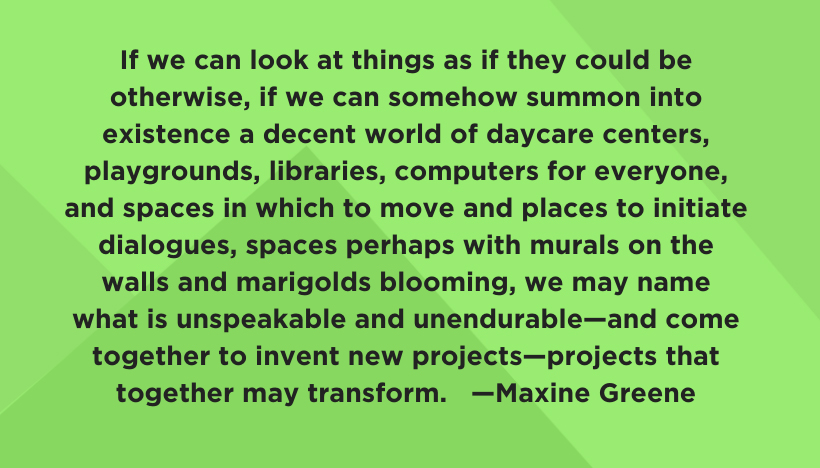From the NCTE Committee on Global Citizenship
This post was written by NCTE member Caroline Santinelli, a member of the NCTE Standing Committee on Global Citizenship.
All this demands the activity of what we are calling a social imagination—a capacity to envisage a transcending of the violence, the unfairness, the alienation, the carelessness we see and feel around us. I would hope, as you do, that the evils and deficiencies on our minds today will be named, viewed as obstacles to the becoming we hope for in collaboration with the diverse young. I am convinced that the work of social imagination . . . should be focal in bringing into being the image (and, perhaps, the palpable realities) of a better state of things. There can be no guarantees; we all know that. But, if we can look at things as if they could be otherwise, if we can somehow summon into existence a decent world of day-care centers, playgrounds, libraries, computers for everyone, and spaces in which to move and places to initiate dialogues, spaces perhaps with murals on the walls and marigolds blooming, we may name what is unspeakable and unendurable—and come together to invent new projects—projects that together may transform.
—Maxine Greene
Welcome, educators. I write to you today from the space formerly known as my bedroom which can now also be classified as my classroom, Pilates studio, meditation room, office space, and happy hour location. Needless to say, we are all reimagining and recontextualizing the spaces we thought we knew as we both embrace and wrestle with the start of a new school year in 2020.
Back in July, Greene’s words appeared in my inbox from my school’s new Director of Studies, Chance Sims. (This was his way of introducing himself to the faculty and staff at our high school. Can you say “mic-drop?”) “For Greene,” he wrote, “the act of seeing is an important step in the becoming of new imaginations. Developing the ability to see the ‘marigolds blooming’ brings us to the critical educational question: How do we develop ways of seeing that make it possible to imagine the world differently?”
How, indeed.
Greene asserts in her essay “The Ambiguities of Freedom” that we must name “the evils and deficiencies . . . what is unspeakable and unendurable” in our world. The act of naming seems like a good, if not crucial, place to start. We must name—and, I would add, understand—these contexts in order to begin to imagine something different.
When thinking about naming the contexts for a new lesson or text—be it the politics around its existence, crucial concepts, or the author’s background—I often think of lawyer and activist Bryan Stevenson and his view on the value of history. In an interview, Vox political journalist Ezra Klien asked Stevenson, “What is a healthy relationship for society to have with its own history?” Stevenson replied: “Knowing the actual history. If you don’t know your history, you can’t really begin to understand what your obligations are, what your responsibilities are, what you should fear, what you should celebrate, what’s honorable and what’s not honorable . . . . Once you know that history, you begin to think differently about who we are.”
Greene, in her 2000 article, and Stevenson, writing more recently, show a shared belief in the liberatory nature of context. If we can know, name, and understand the contexts and structures that dictate the global challenges we face, “vision may appear before [our] mind’s eye—visions of what might be, what ought to be,” as Greene wrote. “Experiences of this kind are what direct attention to the deficiencies, the inequities in lived situations; they may, in fact, provoke persons to take action together—to transcend the deficiencies, to transform.”
It is certainly not a novel idea that context is important. Yet beginning every school year with my impressionable high schoolers is a stark reminder of how a lack of context negates the value of even the most powerful stories. The importance of context for teenage learners is a reminder of the importance of context for all of us as learners or as educators. Without graspable and retainable contextualization, stories cannot ignite real transformation in our world.
It begins, I think, with the same maxim I hear repeated all too often now—be it in response to concerns about the spread of COVID-19 or the omnipresent effects of climate change: Listen to the science. We must teach ourselves how to help students learn to retain and remember the contexts they need in order to understand the underlying structures of contemporary global problems and see new possibilities.
It is, therefore, our duty as globally minded educators to know the answers to six key cognitive science questions:
- How do students understand new ideas?
- How do students learn and retain new information?
- How do students solve problems?
- How does learning transfer to new situations in or outside of the classroom?
- What motivates students to learn?
- What are common misconceptions about how students think and learn?
(Source: The Science of Learning)
These six core questions of cognitive science offer a roadmap for designing educational experiences that can empower students to identify informed and innovative solutions to our global problems.
When I first read The Science of Learning, I immediately flipped to question four: How does learning transfer to new situations in or outside of the classroom? The quick answer to question four? Knowing and retaining context. As summarized by Deans for Impact:
- The transfer of knowledge or skills to a novel problem requires both knowledge of the problem’s context and deep understanding of the problem’s underlying structure.
- We understand new ideas via examples, but it’s often hard to see the unifying underlying concepts in different examples. (Source: The Science of Learning)
For my students, the process of truly contextualizing and retaining their learnings is tied to the most basic principle of learning science: Students learn new ideas by referencing ideas they already know.
The working memory (in which information is consciously processed) of my high school students is overloaded with sensory inputs that range from class lessons (for at least six disciplines), a 24-hour news cycle, unlimited access to television online, the latest TikTok video . . . and that’s just the beginning. If I cannot connect the context of our unit to something already banked in their long-term memory, it will become just another sensory input discarded after a brief stint in the short-term memory.
So how do we compete with the onslaught of content? I say we must learn how to make context impossible to forget: Listen to the science. In addition to the resources I cited earlier, one excellent resource is the organization retrievalpractice.org, founded by cognitive scientist Dr. Pooja K. Agarwal, who is also the author of Powerful Teaching: Unleash the Science of Learning. On her site, Dr. Agarwal curates research, resources, and teaching strategies that educators can use to employ the key methods for retaining learning.
Teaching context in ways that are retainable and remembered—in ways that make accessible new spaces for inquiry and ways of knowing the world—is the liberatory tool we need in order to, in Greene’s words, “develop new ways of seeing.” As the world’s problems become increasingly global, there has never been a more apt moment for a “social imagination.” We must help our students learn how to “name what is unspeakable and unendurable—and come together to invent new projects—projects that together may transform” (Greene, 2000).
We must help our students make context stick.
Resources
The Science of Learning by Deans for Impact (2015)
The Ambiguities of Freedom by Maxine Greene (2000)
Bryan Stevenson on How America Can Heal by The Ezra Klein Show (2020)
Retrievalpractice.org (2019)
Powerfulteaching.org (2020)
Additional Resources
The Science of Learning—What Every Teacher Should Know (Free online course by Edx and Teachers College, Columbia University)
Make it Stick: The Science of Successful Learning by Peter C. Brown, Henry L. Roediger, and Mark A. McDaniel (2014)

Caroline Santinelli teaches ninth and eleventh grade English at the Branson School in Ross, California. Additionally, she is a National Geographic Certified Educator and a part-time student in the cognitive science in education program at Teachers College, Columbia University. She believes in designing learning experiences that foster a climate of inquiry by positioning texts in context with the broader social and geopolitical issues in students’ lives and worlds. Her goal is to guide her students toward designing lives of consequence as they prepare to engage in their local and global communities.
The Standing Committee on Global Citizenship works to identify and address issues of broad concern to NCTE members interested in promoting global citizenship and connections across global contexts within the Council and within members’ teaching contexts.
It is the policy of NCTE in all publications, including the Literacy & NCTE blog, to provide a forum for the open discussion of ideas concerning the content and the teaching of English and the language arts. Publicity accorded to any particular point of view does not imply endorsement by the Executive Committee, the Board of Directors, the staff, or the membership at large, except in announcements of policy, where such endorsement is clearly specified.

